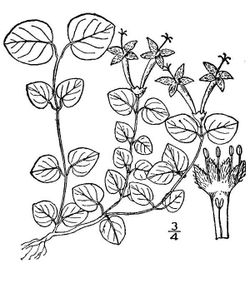Mitchella repens
| Partridge berry | |
|---|---|

| |
| Leaves and berry | |

| |
| Flowers and berry | |
| Scientific classification | |
| Kingdom: | Plantae |
| Clade: | Tracheophytes |
| Clade: | Angiosperms |
| Clade: | Eudicots |
| Clade: | Asterids |
| Order: | Gentianales |
| Family: | Rubiaceae |
| Genus: | Mitchella |
| Species: | M. repens
|
| Binomial name | |
| Mitchella repens | |
Mitchella repens (commonly partridge berry or squaw vine) is the best known plant in the genus ).
Names
Mitchella repens is one of the many species first described by Carl Linnaeus. Its species name is the Latin adjective repens, which means "creeping". Common names for Mitchella repens include partridge berry,[1][2][3][4][a] squaw vine,[5][b] twin berry,[6][7][c] two-eyed berry,[8] running box,[7] checker berry[7][d] and tea berry[7][e] in English.
In aboriginal languages, it is known as binemiin, binemin and binewimin in Ojibwe,[8] noon-yeah-ki'e oo-nah'yea in Onondaga[9] and fiːtó imilpá in Koasati (Coushatta).[7]
Description
The partridge berry is an evergreen plant growing as a non-climbing vine, no taller than 6 cm tall with creeping stems 15 to 30 cm long. The evergreen, dark green, shiny leaves are ovate to cordate in shape. The leaves have a pale yellow midrib. The petioles are short, and the leaves are paired oppositely on the stems. Adventitious roots may grow at the nodes;[6] and rooting stems may branch and root repeatedly, producing loose spreading mats.
The small, trumpet-shaped, axillary flowers are produced in pairs, and each flower pair arises from one common



The
The common reproduction is vegetative, with plants forming spreading colonies.[15]
Distribution and habitat
The species is dispersed throughout eastern North America, from south Eastern Canada south to Florida and Texas, and to Guatemala. It is found growing in dry or moist woods, along stream banks and on sandy slopes.
Cultivation and uses
Mitchella repens is cultivated for its ornamental red berries and shiny, bright green foliage.[15] It is grown as a creeping ground cover in shady locations. It is rarely propagated for garden use by way of seeds but cuttings are easy.[16] The plants have been widely collected for Christmas decorations, and over collecting has impacted some local populations negatively.[15] The plants are sometimes grown in terrariums.[17]
The scarlet berries are edible
Traditionally, the plant had numerous medicinal uses including as a diuretic (by the
Notes
- ^ Or partridgeberry. This name sometimes refers to Vaccinium vitis-idaea (the lingonberry), but wild partridgeberry is more common for that species.
- ^ Or squaw berry.
- ^ Or twinberry.
- ^ This name usually refers to Gaultheria procumbens (the American wintergreen).
- ^ This name usually refers to Gaultheria procumbens (the American wintergreen).
References
- ISBN 978-0-395-91172-3.)
{{cite book}}: CS1 maint: multiple names: authors list (link - ISBN 978-0-88192-557-9.)
{{cite book}}: CS1 maint: multiple names: authors list (link - ISBN 978-0-87773-639-4.
- ISBN 978-0-674-00884-7. Retrieved 2007-11-16.
- ISBN 9781592335831
- ^ a b Nathaniel Lord Britton; Addison Brown (1913). An illustrated flora of the northern United States, Canada and the British possessions: from Newfoundland to the parallel of the southern boundary of Virginia, and from the Atlantic Ocean westward to the 102d meridian. Vol. 3. C. Scribner's sons. pp. 255–. Retrieved 4 September 2010.
- ^ ISBN 9780203491881
- ^ a b "Mitchella repens L." at the Northern Ontario Plant Database. Retrieved 30 June 2023.
- doi:10.2307/533477
- ^ Reproductive Biology of Distylous Partridgeberry, Mitchella repens. David J. Hicks, Robert Wyatt and Thomas R. Meagher Vol. 72, No. 10 (Oct., 1985), pp. 1503-1514 Stable URL: https://www.jstor.org/stable/2443300
- ^ Fecundity in Distylous and Self-Incompatible Homostylous Plants of Mitchella repens (Rubiaceae) Fred R. Ganders Vol. 29, No. 1 (Mar., 1975), pp. 186-188 Published by: Society for the Study of Evolution Stable URL: https://www.jstor.org/stable/2407152
- ISBN 978-0-486-20793-3. Retrieved 4 September 2010.
- ISBN 978-1-56164-347-9. Retrieved 4 September 2010.
- ISBN 978-0-8203-2748-8. Retrieved 5 September 2010.
- ^ ISBN 978-0-88192-549-4. Retrieved 4 September 2010.
- ISBN 978-0-395-96609-9. Retrieved 4 September 2010.
- ^ "Lady Bird Johnson Wildflower Center - the University of Texas at Austin".
- OCLC 799792.
